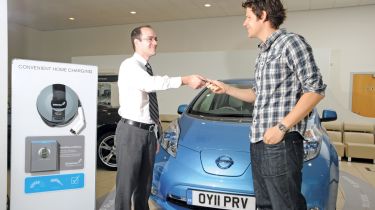Nissan Leaf: First report
We’ve picked up the keys to the Nissan Leaf EV trailblazer – and it’s impressed already

It's time for a change. A big change. In recent years, I’ve been lucky enough to run some really desirable cars, from a Mitsubishi Evo X to a Ford Focus RS. But now it’s the turn of something revolutionary and eco-friendly. For the next six months, I’ve got my hands on the first proper production electric car – a Nissan Leaf.
Normally, additions to the Auto Express fleet are delivered to our offices, but the Leaf is so far removed from anything I’ve ever driven – Mitsubishi i-MiEV included – I thought I’d let a Nissan dealer do the handover.
So I headed over to WLMG in Mill Hill, north London. WLMG is one of Nissan’s EV dealers, featuring a fast charger – which boosts the Leaf’s batteries to 80 per cent in just 30 minutes – and specialist salespeople such as Steve Welch.
“A full charge from a normal socket will take around eight hours. As for driving it, all you do is press the ‘On’ button, select ‘Drive’ and off you go. It’s that simple,” he told me.
Steve also talked me through the Leaf’s many clever features, including systems which tell you how economical your driving is – light-footed behaviour is rewarded by a number of digital ‘trees’ which ‘grow’ on the dashboard – and the sat-nav which guides you to the nearest charging station.
Used - available now
Silently pulling away from the dealership and on to the slip road, I was surprised by the 108bhp electric motor’s shove. Yes, the 0-60mph time of 11.9 seconds might sound slow, but you’ll rocket away from other traffic in town, and the Leaf can easily hold its own on fast A-roads and motorways, too.
Factor in decent visibility, light but accurate steering and agile handling, and first impressions are good. So far, range anxiety hasn’t been a problem. We have charging bays in our central London car park, so I can drive into work (Congestion Charge free) and top up while I’m in the office.
As I live in a first floor flat, I can’t run a lead from my front room window and charge the Leaf up at home, though. So I have to make a short trip to Crouch End’s only electric bay, some 10 minutes’ walk from the house.
To use it, you need a Source London card, which costs £75 a year and gives you access to hundreds of charging points (and free parking) across the capital. All you do is touch the card on the side of the charging point to open up the flap and plug in.
Alternatively, you can have a fixed charging point installed at your home by British Gas. Hardwired to your domestic electricity supply, it is able to carry a higher current than the unit supplied with the car. The only downside is that you’ll need to shell out around £1,000 to have the kit fitted.
Fully charged, the Leaf is claimed to have a range of around 100 miles, and you can extend that by selecting Drive Eco mode, which has a greater regenerative braking effect. But I can’t seem to get more than 70 miles at the moment, although that does mean my weekly commute can be just about done on one charge.
The problems will come when I try to go further afield – and I have to use the heater, too (switching on the air-con and other ancillaries can knock 20 miles off the range). By the time you read this, I’ll have competed in the Brighton to London RAC Future Car Challenge – a 60-mile trip that will be a real challenge for the Leaf. I’ll let you know how I get on in my next report.
Extra Info
“Range is never an issue for me, while the silent cabin and supple ride are very relaxing. As I live only six miles from the office, there’s no better way to travel to and from work than in the Leaf – a point proven when I turned down a spin in the new Vauxhall Corsa VXR Nurburgring recently and snatched the keys to the Nissan instead.”
Jack Rix, Deputy motoring editor











